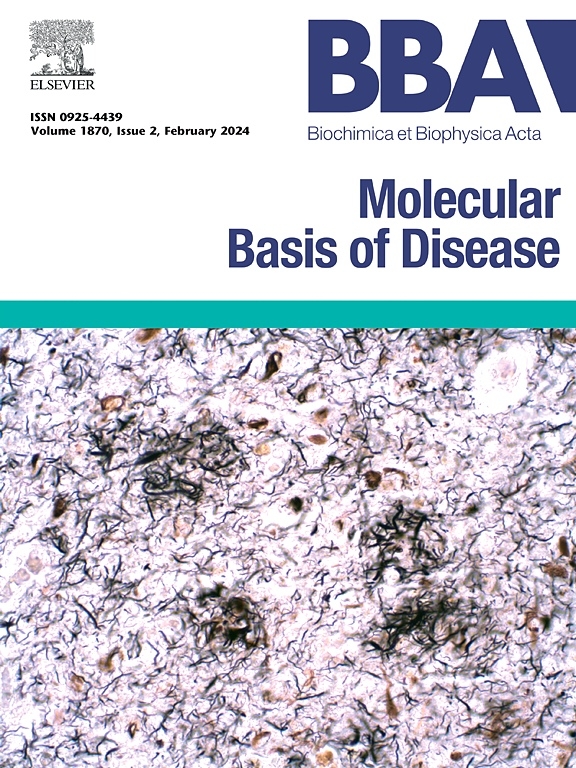PCTH: a novel orally active chelator of the aroylhydrazone class that induces iron excretion from mice
IF 4.2
2区 生物学
Q2 BIOCHEMISTRY & MOLECULAR BIOLOGY
Biochimica et biophysica acta. Molecular basis of disease
Pub Date : 2004-12-24
DOI:10.1016/j.bbadis.2004.09.001
引用次数: 0
Abstract
β-Thalassaemia major is an inherited blood disorder which is complicated by repeated blood transfusion and excessive gastrointestinal iron (Fe) absorption, which leads to toxic Fe overload. Current treatment using the chelator, desferrioxamine (DFO), is expensive and cumbersome since the drug requires long subcutaneous infusions and it is not orally active. A novel chelator, 2-pyridylcarboxaldehyde 2-thiophenecarboxyl hydrazone (PCTH), was recently designed and shown to have high Fe chelation efficacy in vitro [E.M. Becker, D.R. Richardson, J. Lab. Clin. Med. 134 (1999) 510–521; D.R. Richardson, et al., Biochim. Biophys. Acta 1536 (2001) 133–140]. The aim of this investigation was to examine the Fe chelation efficacy of PCTH in vitro implementing primary cultures of cardiomyocytes and in vivo using mice. We showed that PCTH was significantly (P<0.005) more effective than DFO at mobilising 59Fe from prelabelled cardiomyocytes. Moreover, PCTH prevented the incorporation of 59Fe into ferritin during Fe uptake from 59Fe-labelled transferrin. These effects were important to assess as cardiac complications caused by Fe deposition are a major cause of death in β-thalassaemia major patients. Further studies showed that PCTH was orally active and well tolerated by mice at doses ranging from 50 to 200 mg/kg, twice daily (bd), for 2 days. A dose-dependent increase in faecal 59Fe excretion was observed in the PCTH-treated group. This level of Fe excretion at 200 mg/kg was similar to the same dose of the orally effective chelators, pyridoxal isonicotinoyl hydrazone (PIH) and deferiprone (L1). Effective Fe chelation in the liver by PCTH was shown via its ability to reduce ferritin-59Fe accumulation. Mice treated for 3 weeks with PCTH at doses of 50 and 100 mg/kg/bd showed no overt signs of toxicity as determined by weight loss and a range of biochemical and haematological indices. In subchronic Fe excretion studies over 3 weeks, PIH and PCTH at 75 mg/kg/bd for 5 days/week increased faecal 59Fe excretion to 140% and 145% of the vehicle control, respectively. This study showed that PCTH was well tolerated at 100 mg/kg/bd and induced considerable Fe excretion by the oral route, suggesting its potential as a candidate to replace DFO.
PCTH:一种新的口服活性芳基腙类螯合剂,可诱导小鼠铁排泄。
重度地中海贫血是一种遗传性血液疾病,其并发症是反复输血和胃肠道铁(Fe)吸收过多,从而导致有毒的铁过载。目前使用螯合剂去铁胺(DFO)的治疗既昂贵又麻烦,因为该药物需要长时间的皮下输注,而且不具有口服活性。一种新型螯合剂- 2-吡啶基甲醛- 2-噻吩羧基腙(PCTH)在体外具有较高的铁螯合效果。本研究的目的是在体外进行心肌细胞原代培养和小鼠体内研究PCTH对铁的螯合作用。我们发现PCTH显著(P
本文章由计算机程序翻译,如有差异,请以英文原文为准。
求助全文
约1分钟内获得全文
求助全文
来源期刊
CiteScore
12.30
自引率
0.00%
发文量
218
审稿时长
32 days
期刊介绍:
BBA Molecular Basis of Disease addresses the biochemistry and molecular genetics of disease processes and models of human disease. This journal covers aspects of aging, cancer, metabolic-, neurological-, and immunological-based disease. Manuscripts focused on using animal models to elucidate biochemical and mechanistic insight in each of these conditions, are particularly encouraged. Manuscripts should emphasize the underlying mechanisms of disease pathways and provide novel contributions to the understanding and/or treatment of these disorders. Highly descriptive and method development submissions may be declined without full review. The submission of uninvited reviews to BBA - Molecular Basis of Disease is strongly discouraged, and any such uninvited review should be accompanied by a coverletter outlining the compelling reasons why the review should be considered.

 求助内容:
求助内容: 应助结果提醒方式:
应助结果提醒方式:


